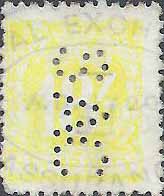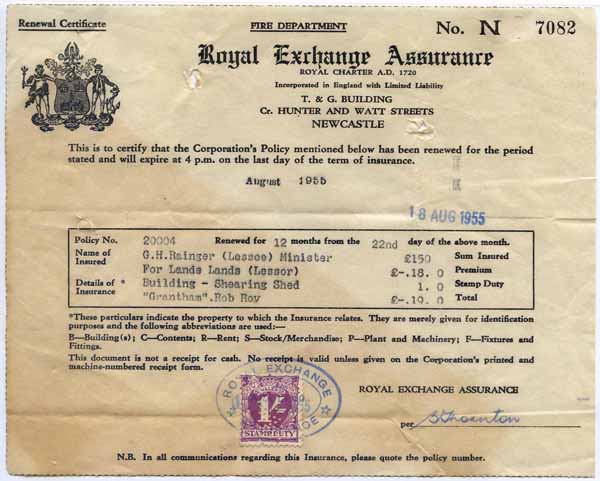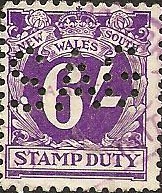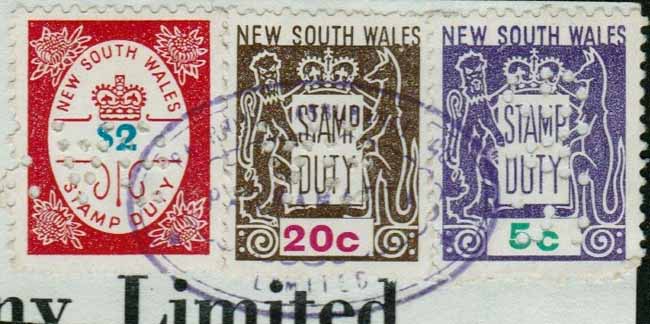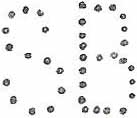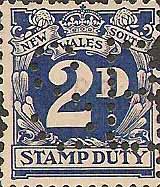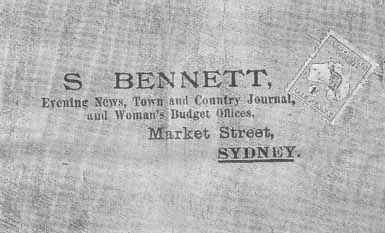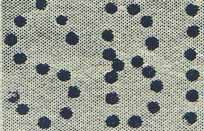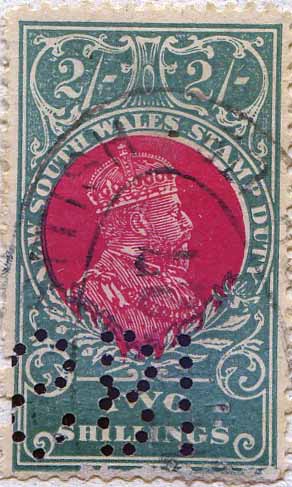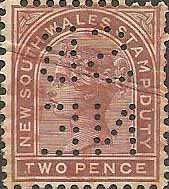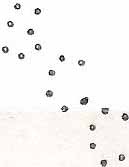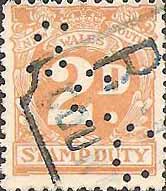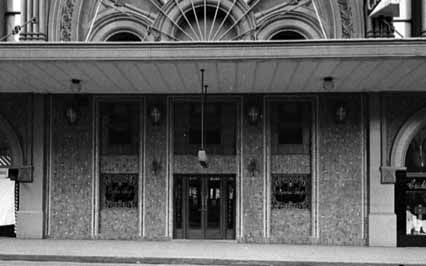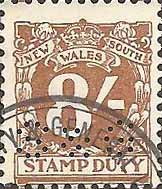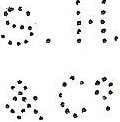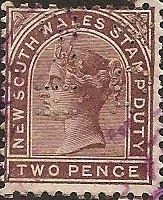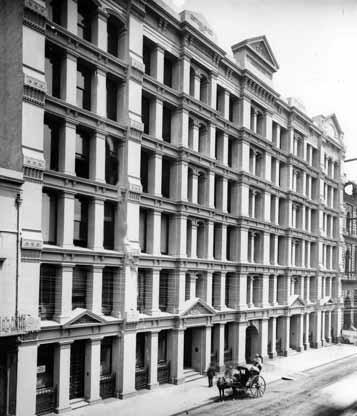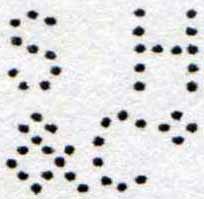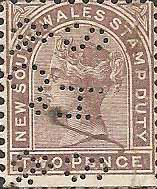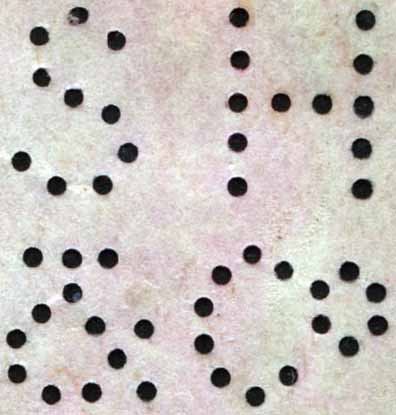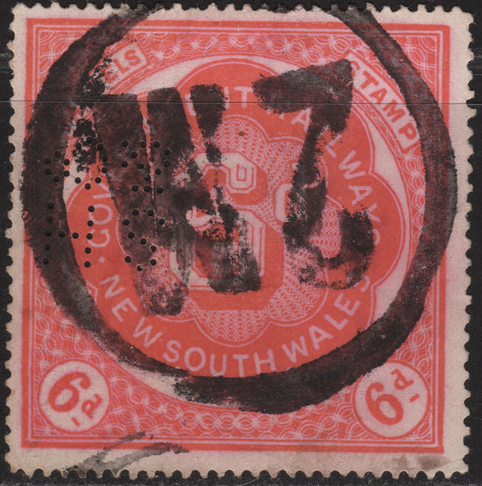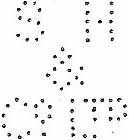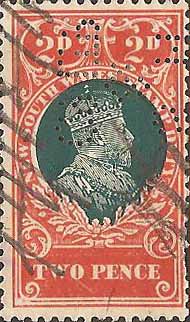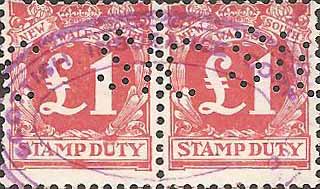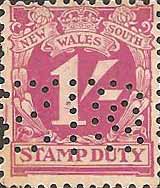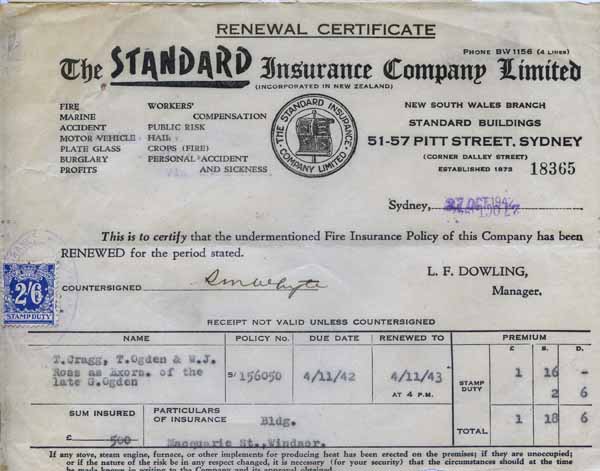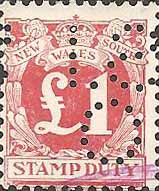|
Private Revenue Perfins of New South Wales An Elsmore Coath production The authors would welcome your comments additions or input into this work A B C D E F G H I J K L M N O P Q R S T U V W Y Other S -------------------------------------------------------- SAC.a
User: State Assurance Co Ltd Insurance Provider Address: 75-77 Pitt St, Sydney, NSW From 1960 'Kindersley House' 33-35 Bligh St through to 20-26 O’Connell Sts, Sydney, NSW Revenue Use: Numeral 1929-66 issue 3d, 6d, 8d, 9d, 1/-, 1/6, 2/-, 2/6, 4/-, 5/-, 6/-, 18/-, £1, 30/- Rarity Scale: Numeral 1929-66 issue 3d R4, 6d R3, 8d R3, 1/- R4, 1/6 R3, 2/- R4, 2/6 R4, 4/- R4, 5/- R4, 6/- R4, 18/- R4, £1 R4, 30/- R4 Background: The State Assurance Co Ltd was established in Liverpool in 1891, as the State Fire Insurance Company and the company provided fire insurance in the United Kingdom, Australia and the USA. In 1910 it was renamed State Assurance Company and the company expanded into general insurance. The company had offices in Sydney from at least 1913. In 1923 they acquired the fellow insurer British Equitable Assurance. In September 1924 The State Assurance Co Ltd was in turn acquired by the Royal Exchange Assurance Co and became part of the Royal Exchange Assurance group which operated in its own right, but also traded through a number of subsidiary companies in Australia including both, State Assurance Co. Ltd. and British Equitable Assurance Co. Ltd. but also Java Sea and Fire Insurance Co. Ltd., Congregational Insurance Co. of Australia Ltd., Australia of the Sea Insurance Co. Ltd., Fire and Accident Insurance Co. of Australasia Ltd. and the Batavia Sea and Fire Insurance Co. Ltd. (later named Australian and Eastern Insurance Co. Ltd). In 1968 Royal Exchange Assurance combined with the Guardian Assurance Company Limited to form Guardian Royal Exchange Assurance and in 1999 this group was acquired by AXA. Device: The SAC.a device is most likely a multi die device of at least 2 and possibly 3 dies. Multiples are rare so we do not have many reference pieces, but in the ones that we have seen there is a consistency between strikes but this shows in the form of 2 slightly different separations. This is similar to some of the other 3 die devices used by Insurance Companies in Sydney at around the same time, such as AMF.a .b .c and MM .a .b .c. The SAC.a pattern is only found on the revenue stamps of NSW and only in the period 1941 until the early 1960s. Related Patterns: Refer to other Atlas, Royal Exchange and related company patterns in: NSW: A.a A.b A.c A.d BEA.a GAC.a REA.a REA.b Other – Section 2 Commercial Overprints A(Atlas).a Royal/Exchange/Assurance.a State/Assurance/Co Ltd.a QLD: A.a
Royal Exchange Assurance, using perfin SAC.a -------------------------------------------------------- SAG.a
User: Patriotic Assurance Co Insurance Provider Address: 29 Queen Street, Melbourne, VIC Revenue Use: Numeral 1929-66 issue 6/- 1966 issue 5c, 15c, 20c, $2 Rarity Scale: Numeral 1929-66 issue 6/- R4 1966 issue 5c R4, 15c R4, 20c R4, $2 R4 Background: Patriotic Assurance Co. was founded in 1824 in Ireland, with the Head Office at 9 College Green, Dublin, in 1900. The company opened an Australian office in late April, 1900, the first Chairman of Directors being The Hon. Frederick Thomas Derham, son-in-law of Thomas Swallow of Swallow & Ariell (in which company he became sole director in 1890 on Swallow’s death). (By 1926, Frederick Thomas Derham’s son, Frederick John, was a director of Patriotic Assurance Co. (At the same time, F.J. Derham was also managing director of Swallow & Ariell). The Australian Branch of Patriotic Assurance Co. was located at 29 Queen Street, Melbourne, with Charles E. Lloyd as Australian manager. In September, 1900, J. Barre Johnston & Co. in Sydney were appointed agents for N.S.W., while the agency for South Australia opened in the Grenfell Buildings in Adelaide in October, 1901. Within two years Patriotic Assurance Co. had offices in Brisbane (June, 1901) with Stewart & Hemmant as chief agents for Queensland, and in Bundaberg (February, 1902). With offices in other colonies 29 Queen Street became simply the Victorian branch. In February, 1906, Patriotic Assurance Co. became affiliated with Sun Insurance Co. (founded 1710) continuing business in its own name. From November, 1923, the business of both Patriotic Assurance Co. and Sun Insurance Co. was conducted from Sun Insurance Buildings at 34 Queen Street, corner of Flinders Lane, Melbourne. In the early years, the company was sometimes called Patriotic Fire Assurance Co. or Patriotic Assurance Co. (Fire) because it offered only fire insurance. Later policies were offered for accidents and other risks eventually including third party motor insurance (Licence renewal in N.S.W., 1971). In February, 1942, Patriotic Assurance Co. was among the insurance companies approved by the War Damage Commission to offer insurance related to war damage risk. In 1964, Patriotic Assurance Co. moved to 408 Queen Street, Melbourne, where it was still located in 1971. Device: As stated in the Background this is an extremely rare pattern and we have seen only a single example. Therefore we have little evidence to determine the structure and usage range of the device. The device is most likely a single die device as if the usage volume of the company had necessitated the purchase of a multi die device then there would more than likely been more examples found of the pattern. The pattern is found in position 1 and given that it is 3 letters wide there is only a small distance between the S and the G and the edge of the stamps. Therefore it is possible that the letters SAG are actually part of a larger pattern. If this is the case then it is most likely that the device was not intended as a Perfin and could have been a Cancelling device or similar. Related Patterns: Nil
-------------------------------------------------------- SB.a, .b, .c, .d, .e, .f, .g, .h, .i, .j, .k, .l
User: S Bennett Newspaper Provider Address: 49 Market St, Sydney, NSW Revenue Use: Numeral 1917 issue 2d Numeral 1929-66 issue 2d[blue], 1/- Rarity Scale: Numeral 1917 issue 2d R4 Numeral 1929-66 issue 2d[blue] R4, 1/- R4 Background: *Samuel Bennett was born in Cornwall, England on 28 March 1815, and he married Eliza (nee Sellers) in 1840 before emigrating to NSW in 1841, as a printer, on an assisted passage arranged with the proprietors of the Sydney Morning Herald. Bennet rose to the position of head of printing at the Sydney Morning Herald but in 1859 he joined with William Hanson, the then Government Printer, to purchase the newspaper the 'Empire' from Henry Parkes (later Sir) and it was published daily until 1875. Bennett was also interested in the history of Australia and some historical pieces appeared in Empire, and later a complete book called ‘The History of Australian Discovery and Colonization’ was published in 1867. The partnership with Hanson was dissolved in 1867 and Bennett took control of the company and that same year he launched Sydney’s first evening paper, entitled the ‘Evening News’. In 1870 he launched another newspaper this time a weekly entitled the ‘Australian Town and Country’, which focused on information and education as well as the news. The Journal covered a broad range of topics including literature, science, agriculture, and reports from rural towns. In 1875 labour problems forced Bennett to amalgamate the Evening News and Empire but the papers continued to flourish in the increasingly competitive NSW newspaper market. Bennett suffered a slight accident at his home and he developed tetanus and died on 2 June 1878. Although he and Eliza had had 7 children only 3 survived at the time of Bennett’s death. His sons Frank and Christopher were already working with their father and on his death they continued the business as a family partnership before becoming a public company, S Bennett Ltd, which had major shareholders in retailers Soul Pattison and the Farmer family. S Bennett Ltd merged with Sun Newspapers Ltd in 1931 to form Associated Newspapers and this company went onto acquire many Sydney newspaper assets. Device: Initial reports of this pattern, it was listed as a single pattern in CPA (1992), gave the confirmed user as Sargood Brothers. Subsequently an article in the SPPB (#46) of July 1999 showed an envelope in the collection of John Fordham, that had an SB.a tied to a return addressed envelope to S Bennett. (See below). This envelope with its return address details is entirely consistent with its use as a reply paid envelope for subscription payments or the like. Bennett’s publications were available through news agencies and general stores, but also by subscription, which ensured that, the newspaper was delivered via the post. At around 1900 the Town and Country Journal was sold over the counter for 6 d an issue or post free for an annual subscription of just £1-7s-2d. We have not sighted any cover or document that would support the user as Sargood Brothers and we consider that the Fordham cover provides confirmation of the true user. The SB.a-.l device was a 12-die device in a horizontal array with a gap between dies 6 and 7. The dies are all identifiable and accordingly we have listed them as 12 separate patterns. It is notable the only half of the SB.l pattern is known. The spacing of the dies makes it suitable for puncturing the small format postage and revenue stamps of NSW, but the dies are large and they occupy a great deal of the stamp. Therefore central strikes require the operator to exercise some care and this does not seem to have been the case, as there are frequent partials and these become more frequent when the device is used on stamps of different formats such as the Kangaroo and KGV issues of Australia. The patterns are found on the revenue and postage stamps of NSW from about 1908, and from 1913 on the postage stamps of Australia until 1930. The patterns are also reported on the postage stamps of the States of Queensland, South Australia, Tasmania and Victoria, but this usage is restricted to the immediate pre Commonwealth period around 1912 when postal authorities were allowing cross State usage in order to use up stocks of States stamps prior to the introduction of the Kangaroo series in 1913. The pins in the SB.a-.l device were rather thin and overtime some of these are lost through wear and tear. In around 1926 the SB.a-.l device was modified and thicker pins were fitted.
John Forham’s envelope. Note folding indicating that it was likely an enclosure in another envelope. Related Patterns: Nil *Trove
*The Australian Dictionary of Biography
*‘Two Hundred Years of Sydney Newspapers: A Short History’ Victor Isaacs and Rod Kirkpatrick -------------------------------------------------------- SBI.a
User: The South British Insurance Co Ltd Insurance Provider Address: Hunter & O'Connell St's, Sydney, NSW Revenue Use: KEDVII 1909-28 issue 4d, 8d, 1/-, 2/-, 3/-, 4/-, 5/-, 6/-, 7/-, 8/-, 10/-, 15/- Numeral 1929-66 issue 3d, 4d, 6d, 8d, 9d, 1/-, 1/6, 2/-, 2/6, 2/6[orange], 3/-, 4/-, 5/-, 6/-, 8/-[brown], 8/-, 10/-, 12/-, 14/-, 18/-[yellow], 18/-, £1, 30/-, £5, £10 Decimal 1966 issue 1c, 2c, 3c, 4c, 5c, 6c, 8c, 10c, 15c, 20c, 25c, 30c, 35c, 40c, 50c, 60c, 70c, 80c, 90c, $1, $1.20, $1.40, $1.60, $1.80, $2, $3 Rarity Scale: KEDVII 1909-28 issue 4d R3, 8d R3, 1/- R2, 2/- R3, 3/- R4, 4/- R4, 5/- R3, 6/- R4, 8/- R4, 10/- R4, 15/- R4 Numeral 1929-66 issue 3d R2, 4d R1, 6d R2, 8d R2, 9d R4, 1/- R2, 1/6 R1, 2/- R1, 2/6 R2, 2/6[orange] R4, 3/- R1, 4/- R1, 5/- R1, 6/- R2, 10/- R3, £1 R1, 30/- R4, £5 R4, £10 R4 Decimal 1966 issue 1c R4, 2c R4, 3c R4, 5c R4, 6c R4, 8c R4, 10c R4, 15c R4, 20c R4, 25c R4, 30c R4, 35c R4, 40c R4, 50c R4, 60c R4, 70c R4, 80c R4, 90c R4, $1 R4, $1.20c R4, $1.40c R4, $1.60 R4, $1.80c R4, $2 R4, $3 R4 Background: *The South British Insurance Co Ltd was established in June 1872 as the South British Fire and Marine Insurance Company of New Zealand and in October 1907 it was incorporated and renamed the South British Insurance Co Ltd. By 1906, South British was offering fire marine and accident insurance and from 1907 motor insurance. South British acquired the Guardian Trust and Executors Company of New Zealand Ltd in 1915 and began to offer fidelity insurance and later life assurance. In 1981, the company merged with the New Zealand Insurance Company Ltd to form the New Zealand South British Group Ltd, but in 1984 they were renamed as the NZI Corporation Ltd. This company was subsequently acquired by the General Accident Fire and Life Assurance Corporation in 1989. Device: The SBI.a device is a single die device as multiple strikes of the pattern do not show any consistent relationship to each other. In addition the device is able to make single and central strikes in both positions 1 and 2 in the large format Edward VII bi-colour issues and this would not be possible with a multi die device in a horizontal array. The SBI.a pattern is only found on the revenue stamps of NSW and then only in the period from about 1926 until at least 1966. HAPP lists an isolated use in 1911 but this rather odd usage is not supported by the cachet dates that we have seen. When the device came into service the contemporary NSW revenue issues were the Edward VII bi colours and the device is very suited to stamps of this size. Strikes on the smaller NSW numeral series seem out of scale and quite often appear as only partials. By 1960 the device has many consistent missing pins and often the pattern appears as just an impression of incomplete holes rather than a clear perfin. Related Patterns: Refer to other New Zealand Insurance Company patterns in: NSW: NZ/IC.a NZ/I/CO.a VIC.a QLD: NZ/IC.a NZ/IC.b NZ/IC.c NZ/IC.d NZ/IC.e NZ/IC.f *AVIVA web site -------------------------------------------------------- SB/NE.a
User: Sargood Butler Nichol & Ewen Warehousemen Address: 24 York St, Sydney, NSW Revenue Use: 1880 issue 2d Rarity Scale: 1880 issue 2d R4 Background: *Frederick Thomas Sargood (later Sir) was born on 30 May 1834 at Walworth, London, son of Frederick James Sargood (d.1873), a merchant, and his wife Emma, (nee Rippon). Frederick (junior) arrived in Melbourne with his parents and five sisters in February 1850. After a short period as a clerk Frederick joined his fathers wholesale soft goods business named Sargood, King & Co. Between 1852-54 he spent time on the Mount Alexander goldfields as well as managing the companies interests in the Bendigo-Castlemaine area. In 1858 he married Marian Rolfe and in 1859 became a junior partner in Sargood, King & Co. His father had entered politics but by 1860 he had returned to England. Frederick (senior) died in 1873. The company prospered and in 1863 they extended their interests interstate, including Sydney and into New Zealand, where the Company was known as Sargood and Sons and Ewen. On his father death Frederick enacted an option in the will to purchase both the Australian and New Zealand business. In 1874 Frederick entered the Victorian parliament in the Legislative Council and in 1879 he oversaw the merger of the family business with the firm of Martin, Butler and Nichol, and by the late 1880’s the company was known as Sargood, Butler, Nichol and Ewen. In 1880 after the death of his wife Marion he retired from politics and took his 9 children to England. Whilst there Frederick remarried (to Julia Tomlin) and 1882 the family returned to Melbourne. Frederick and his sons returned to the family business and by 1897 the company had 14 branches around Australia and New Zealand and employed over 5000 people. They had an office in London, managed by Nichol and Ewing and agencies in New York, Yokohama (Japan) and Hong Kong. Frederick died in January 1903 and was survived by his wife and the 5 sons and 4 daughters of his first marriage. The company was reformed as Sargood Brothers and continued to trade successfully until it was merged with William Gardiner and Co in 1926 to become Sargood Gardiner. Device: The SB/NE.a device was most likely a single die device as it is found on a range of stamp formats including the large ‘Coin’ issues of NSW and it is consistently able to produce single and central strikes. The pattern is found on the revenue and postage stamps of NSW and the device was in use from at least 1904 until 1906. Related Patterns: Refer to other William Gardiner and Sargood Brothers (and related company) patterns in: NSW: WG/CO.a WG&CO.a WG/&/COLD.a WG/&/COLD.b QLD: WG/CO.a VIC: SB.a SB.b SBN.a SG.a *Trove *Australian Dictionary of Biography -------------------------------------------------------- SCC.a
User: Sydney County Council Electricity Distributer Address: 'Queen Victoria Building', George St, Sydney, NSW Revenue Use: Numeral 1929-66 issue 2d, 3d Rarity Scale: Numeral 1929-66 issue 2d C, 3d R1 Background: The Sydney County Council (SCC) was established in 1935 by the passing of the Gas and Electricity Act of 1935 through the NSW parliament. This act gave the SCC authority for the provision and distribution of electricity supplies in Sydney through the various Municipal Councils. At this stage the Electricity Department of the Sydney City Council was transferred to the newly formed SCC. The Authority formally came into operation in 1936. Between 1936 and 1952, it was responsible for electricity generation and distribution, but in 1950 The Electricity Commission of NSW was created to manage electricity generation across all of NSW and from this time the SCC was only responsible for the distribution of the electricity. This distribution responsibility also included the promotion of electricity, electrical products, billing and the collection of payments. This Video shows a short Television commercial from 1959 that features the SCC. The billing aspect is what necessitated the use of revenue stamps as 2d duty was payable on each Electricity bill. The rate of duty increased to 3d in 1956. In 1989, the NSW Government created a State Government controlled Corporation called ‘Sydney Electricity’ which came into being on 1 January 1991 and had the effect of shifting responsibility away from the Municipal Councils to this new Corporation. In 1996, ‘Sydney Electricity’ was merged with Orion Energy to form Energy Australia, which in 2011 changed its name to AUSGRID.
The SCC Head Office in the Queen Victoria Building in George St, Sydney. Device: The SCC.a device is a 10-die device in a horizontal array and somewhat similar in scale and layout, (particularly in the shape of the S) to the GNSW (type C) used to perforate postage and revenue stamps for the NSW Government. This is understandable as both devices were sourced and operated by the NSW Government Printers. One of our contributors, Arthur Taylor from Nowra, NSW, has undertaken a study of these and has created a record of the 10 dies. As you can see the differences are quite subtle between many of dies, but in some it is quite marked, in particular in terms of the shape of the bottom C. The device was in service from 1937 until at least 1956 and it was used frequently. Therefore it is conceivable that the dies may have started out nearly identical and that some of the variation may have been the result of repairs to the device as a result of wear and tear over time. This and the fact that the usage (see Background above) was exclusively single applications of revenue stamps onto Electricity bills, means that it is unlikely that the multiples needed to order the dies will ever be found. If they are to be found then they are most likely to come from strikes on postage stamps, however postal examples are scarcer than examples of the pattern on revenues. The SCC.a pattern is found on the revenue stamps of NSW but also on the postage stamps of Australia. Postal usage does not extend beyond 1942 but as stated above the usage on revenues continues until at least 1956. Related Patterns: Nil -------------------------------------------------------- S&G.a
User: Security & General Insurance Co Ltd Insurance Provider Address: 288 George St, Sydney, NSW Revenue Use: Numeral 1929-66 issue 3d, 6d, 9d, 1/-, 1/6, 3/-, 4/-, 5/-, 8/-[brown], 8/-, 10/-, 18/-, £1, 30/-, £5 Decimal 1966 issue 2d, 8c, 10c, 50c, 80c, $1.60 Rarity Scale: Numeral 1929-66 issue 3d R4, 6d R3, 9d R3, 1/- R4, 1/6 R4, 3/- R3, 4/- R4, 5/- R4, 8/-[brown] R3, 8/- R3, 10/- R4, 18/- R4, £1 R3, 30/- R4, £5 R4 Decimal 1966 issue 2c R4, 8c R4, 10c R4, 50c R4, 80c R4, $1.60 R4 Background: The Security and General Insurance Co Ltd was incorporated in Victoria in January 1938 and over the next few years established branches in Sydney, Brisbane and Perth. The company was not very successful in its early years and had a small turnover. E L Lumley is named as a founding member of the Board and the company was certainly linked to Bernie S Cohen and Son, which later became Edward Lumley Ltd. The company changed its name to Edward Lumley Ltd in June 1974. Device: The S&G.a device was a multi die device as the various strikes show a consistent relationship to each other. It is most likely a 3-die device and there are subtle variations in some of the patterns that we have seen that support this. But the patterns made by the dies are essentially the same so we have listed it as a single pattern. The 3-die horizontal array device is similar to the devices used by many contemporary companies, in particular those in the Insurance industry, and specifically the parent company Edward Lumley Ltd. The device was in service from at least 1963 until 1969. The 1969 usage is rather late as most insurance companies in Sydney stopped using perfins in 1966-67 but it matches the usage by the parent company Edward Lumley Ltd who was known to have used perfins until at least 1970. Related Patterns: Refer to other Edward Lumley companies in: NSW: EL.a -------------------------------------------------------- S.H./& Co..a
User: S.(Sigmund) Hoffnung & Co Ltd.
Importers & Merchants
Address: 165-169 Pitt St, Sydney, NSW Revenue Use: 1880 postage revenue issue 1880 issue 2d Rarity Scale: 1880 postage revenue issue 2d R4 1880 issue 2d R2 Background: Sigmond Hoffnung was born in Poland in 1830, the son of a Jewish Rabbi, but his family migrated to England in 1936. He was educated in Liverpool but due to lack of money he took a job as a junior salesman with a West Country firm. This proved beneficial as he became friendly with a customer, Henry Nathan, who lent him £500 to buy assorted goods and take them to Sydney for resale. Hoffnung arrived in Sydney early in 1852 and opened a wholesale business in Wynyard Square. Sales went well and he was able to repay his loan and subsequently secured more stock from England with Nathan acting as his buyer. This arrangement proved successful and in 1855 Hoffnung moved to larger premises in George Street. He returned to England briefly in 1857 to formalise his partnership with Nathan and to make purchases of more stock. In 1870 S. Hoffnung & Co. moved into new premises in Pitt Street and in 1871 they opened a Brisbane branch. The company also established other branches in Australia, New Zealand and Fiji and had its head office in London. They also had a large factory in Sydney making saddlery and harnesses. Their range of wholesale goods included American canned fruits and jams, watches, glass and china, ironmongery, rocking horses, firearms, iron safes and patent medicines. Hoffnung set up the first opal-cutting business in Australia and exported uncut diamonds and sapphires for industrial use. In 1875 he was on the committee of the Trade Protection Society of New South Wales. In 1877 Hoffnung returned to England and took charge of the London office. His brother Abraham, who had been a successful merchant in America, Canada and England, joined S. Hoffnung & Co. in 1886. Abraham spent some years in both Australia and in London. In 1889 Sigmund retired from the company and it was restructured as a public company in 1902. Later the company moved its headquarters to 153 Clarence Street, Sydney. Hoffnung died on 27 August 1904 aged 74. He was survived by his wife and their only child Sidney. Sidney worked in the company and after marrying Violet Goldsmid, he took the name Hoffnung-Goldsmid. He served as a director of the company and died in 1930.
S Hoffnung and Co premises 165-169 Pitt St, Sydney. Device: S Hoffnung and Co first applied to the NSW postal authorities in 1887 for approval to use a perforating device on their postage stamps. S Hoffnung and Co used a range of devices in their offices in Sydney and Brisbane including various formats of SH, SH/&CO and SH/&/COLTD, but in the main they used an SH/&CO format. There were actually only 3 different SH/CO devices, but the patterns that they made were somewhat similar and it is this similarity that has lead to a myriad of miss reports about usage dates and which stamps they are truly found on. The problems with this pattern group can be summarised as follows: 1. Some reference pattern images in both previous studies of Australian Private Perfins (CPA and HAPP) were not accurate. 2. Some patterns in the SH&CO group are very similar to each other. 3 The patterns from some devices altered over time with some losing pins and these differences were recorded as different patterns. For this assessment we have used the details and numbers from HAPP, and we have written the actual usage after each pattern, they are as follows: SH&CO.1 This is the Brisbane device SH/CO.a in the Queensland section. This is correct in all details and the CPA and HAPP images were good. SH&CO.2 This is a Sydney device SH&CO.b, characterised by a flat topped ampersand. It has been reported on Australian, NSW, QLD postage stamps and on NSW revenues. HAPP reported usage between 1900-1913. We have not been able to find any NSW revenue usage but we have found NSW railway use of this pattern, although it is in a period that revenue usage could have also occurred. The pattern is not found on the postage stamps of Australia and Queensland usage is also questionable. The true usage period was 1901-1911 so any cross State use, such as Queensland use, is unlikely. Queensland postage stamps and some of those from other States, were used in Sydney in order to eliminate stock piles of these stamps prior to issuing the Kangaroo series in 1913. This use was limited to a short period in 1912 and early 1913. SH&CO.3 Sydney device reported only on NSW postage stamps. Reported usage 1888-1900 and 1912. SH&CO.4 Sydney device reported on Australian postage stamps and NSW revenue stamps. Reported usage 1888-1952. In fact SH&CO.3 and SH&CO.4 are the same pattern produced by the same device. The differences shown in CPA and HAPP are the absence of pins between the S and H, and a pin after H and a pin under the O of CO, as well as a different shaped C. These extra pins are not always present or absent and we have seen examples of this pattern with some pins in place and others not. The difference in the C does not exist and it is due to a poor image of SH&CO.4 that is used in both CPA and HAPP. The existence of poor images and miss reports of this pattern are understandable given the large number of pins in the die and their fine nature. Full, clear strikes are the exception. The inaccurately reported usage periods are harder to understand. The device was only used over the period between 1889 and 1913. We can find no postmark evidence of usage from 1888, but it is possible as the company was known to have applied to perforate postage stamps in 1887. What is more significant is that we cannot find usage of the device as late as 1952 (SH&CO.4) as stated in CPA and restated in HAPP. In fact the usage after 1901 is sporadic as the device was in a poor condition and was only one of 3 devices in use by the Company in that location and at that time. This usage up to 1952 is likely based on reports of partial strikes of SH&COLTD.1. (SH/&/COLTD.a) The separation of the S and H in both patterns is about the same and both the SH&COLTD.1 and the SH&CO.3 & .4 frequently show partial strikes or incomplete strikes due to blocked, missing or broken pins. We correct this in our listing of SH/&CO.a with a true usage between 1889 and 1913. This pattern is found on the revenue stamps of NSW as well as the postage stamps of NSW and later, and for a very short time, Australia. SH&CO.5 Another Sydney device reported on the postage and revenue stamps of NSW. Reported usage 1893-1910. These reports are essentially correct but the actual usage began in 1892 and these reports miss the usage on Australian postage stamps up until 1913. The pattern is found on the 1d Kangaroo stamp of 1913. We list this pattern as SH&CO.b with usage between 1892 and 1913. It is found on the revenue and postage stamps of NSW and rarely on the postage stamps of Australia (only 1913) Related patterns: Refer to other S Hoffnung and Co patterns in: NSW: SH/&CO.b SH/&CO.c SH/&/COLTD.a QLD: SH/&CO.a -------------------------------------------------------- SH/&Co.b
User: S.(Sigmund) Hoffnung & Co. Ltd.
Importers & Merchants
Address: 165-169 Pitt St, Sydney, NSW Revenue Use: 1880 issue 2d Rarity Scale: 1880 issue 2d R2 Railway Use: 1891 issue 3d, 1/-, 3/- Rarity Scale: 1891 issue 3d R4, 1/- R4, 3/- R3 Background: See SH/CO.a above Device: See SH/CO.a above Related patterns: Refer to other S Hoffnung and Co patterns in:
NSW: SH/&CO.a SH/&CO.b SH/&/COLTD.a QLD: SH/&CO.a -------------------------------------------------------- SH/&Co.c
User: S.(Sigmund) Hoffnung & Co. Ltd.
Importers & Merchants
Address: 165-169 Pitt St, Sydney, NSW Revenue Use: 1880 2d Rarity Scale: 1880 2d R4 Railway Use: 1891 issue 6d Rarity Scale: 1891 issue 6d R4 Background: See SH/CO.a above Device: See SH/CO.a above Related patterns: Refer to other S Hoffnung and Co patterns in:
NSW: SH/&CO.a SH/&CO.c SH/&/COLTD.a QLD: SH/&CO.a -------------------------------------------------------- SH/&/Co.LTD.a
User: S.(Sigmund) Hoffnung & Co. Ltd.
Importers & Merchants
Address: 165-169 Pitt St, Sydney, NSW 157 Clarence St, Sydney, NSW Revenue Use: KEDVII 1909-28 issue 2d Numeral 1917 issue 1d, 2d Rarity Scale: KEDVII 1909-28 issue 2d R4 Numeral 1917 issue 1d R4, 2d R4 Background: See SH/&Co.a above Device: The SH/&/COLTD.a device came into service in 1913 and this just overlaps the usage of the SH/&CO.b device. The SH/&/COLTD.a device was most likely a single die device as multiple strikes do not routinely show a consistent relationship to each other. In some isolated examples there is a consistent relationship between some horizontal strikes but this is rare and could be a coincidence caused by the stamps being feed under the die in a consistent manner. The device remained in use until at least 1960. The pattern has been reported on the revenue stamps of NSW as well as the postage stamps of NSW, Queensland and Australia. The reports on Queensland postage stamps is suspect as the device did not come into use until the Commonwealth period, although stocks of Queensland stamps were known to have been used in Sydney in 1912. As with some of the earlier Hoffnung devices this SH/&/COLTD.a device had quite thin pins and this resulted in a high number of incomplete strikes. By the 1930’s the pattern showed many consistent missing pins and by the mid 1940’s the pattern is barely recognisable and sometimes appears as just a 'cloud' of incomplete impressions. In about 1958 the device was repaired and it once again produced clear strikes. This later pattern is slightly different and can be identified by the T of LTD, which has a more rounded horizontal crosspiece. Related patterns: Refer to other S Hoffnung and Co patterns in: NSW: SH/&CO.a SH/&CO.b QLD: SH/&CO.a -------------------------------------------------------- SIC.a
User: Scottish Insurance Corporation Ltd Insurance Provider Address: 12-16 Spring St, Sydney, NSW Revenue Use: Numeral 1929-66 issue 3d, 6d, 6d[no wmk], 9d, 1/-, 1/6[no wmk], 2/6, 3/-, 5/-, 8/-[brown], £1, 30/- Decimal 1966 issue 3c, 5c, 60c, 90c, $1 Rarity Scale: Numeral 1929-66 issue 3d R3, 6d R4, 6d[no wmk] R4, 9d R3, 1/- R3, 1/6[no wmk] R4, 2/6 R3, 3/- R4, 5/- R4, 8/-[brown] R3, £1 R3, 30/- R4 Decimal 1966 issue 3c R4, 5c R4, 60c R4, 90c R4, $1 R4 Background: *The Scottish Insurance Corporation Ltd. was formed in 1877 and was in 1885 known as the First Scottish Accident Company. In 1896, the company extended its business to include life and fidelity assurance and to reflect this change the company was renamed the Scottish Accident Life and Fidelity Insurance Company Ltd. In July 1906, the company changed its name again, to the Scottish Accident Life and General Insurance Company Ltd and also increased its range of insurance products to include personal accident, illness, pensions, workmen's compensation, life, endowment, fidelity, motor accident, burglary and housebreaking insurance and, in 1907, it added a fire business. When the company was incorporated (in Perth, Scotland, UK) in March 1911 it changed its name to Scottish Insurance Corporation Ltd. In 1919 the company was acquired by the Scottish Amicable Life Assurance Society but it continued to trade under its own name. The company continued to expand and, by 1934, had added plate glass insurance to its portfolio. By 1963 the company’s main activity was life insurance and in that year it was acquired by the Yorkshire Insurance Company Ltd, which became part of the General Accident Fire & Life Assurance Corporation Ltd in 1967, which is now part of Aviva Insurance Limited. Device: The SIC.a device is a single die device as multiple strikes do not show any relationship to each other. The pattern is only found used on the revenue stamps of NSW. The usage range of the device is difficult to determine, as the company cachets do not carry a date field. Documents show that the address of the company when it was using the SIC.a device was 12-16 Spring St, Sydney, NSW and this is also the office of the Yorkshire Insurance Co Ltd. Therefore it is likely that the device was purchased after the Scottish Insurance Corporation Ltd was acquired by the Yorkshire Insurance Co Ltd. Yorkshire Insurance were long time perfin users having secured a device as early as 1943. If this were the case then the usage would have been from 1963 until at least 1966. Related Patterns: Refer to related company patterns in: NSW: YI.a *Aviva web site -------------------------------------------------------- S.I.Co.a .b .c
User: The Standard Insurance Co Ltd Insurance Provider Address: 51-57 Pitt St, Sydney, NSW Revenue Use: Numeral 1929-66 issue 4d, 6d, 8d, 1/-, 2/-, 2/6, 2/6[orange], 3/-, 4/-, 5/-, 6/-, 10/-, £1 Rarity Scale: Numeral 1929-66 issue 4d R3, 6d R2, 8d R3, 1/- R3, 2/- R2, 2/6 R4, 2/6[orange] R4, 3/- R3, 4/- R3, 5/- R3, 6/- R3, 10/- R3, £1 R4 Background: Standard Insurance Co Ltd, Incorporated in NZ (Dunedin), was formed in 1873 and existed in Australia from at least 1900. They initially traded through agents but the company eventually built a formal branch structure in Australia after WW1. By the 1940’s the company was offering a full range of non life insurance products including, Fire, Accident, Marine, Motor, Plate Glass, Workers Compensation, Personal Accident and various Commercial insurances. The company was absorbed into the follow New Zealand National Insurance Co. Ltd. in the 1960s. Not to be confused with the fellow New Zealand Company, Standard Fire and Marine Insurance Company, which operated in Australia from at least 1878 and was in 1924 acquired by London and Lancashire Insurance Co Ltd. Device: The SICO.a, .b and .c device is a 3-die device in a horizontal array. The 3 dies are distinguishable from each other so we list them as 3 separate patterns. The SICO pattern was first reported in CPA as a single pattern but HAPP listed 2 of the dies but did not indicate that they were part of the same device, or indeed suggest that they were from the same user. The SICO device came into service in about 1934 and was used until at least 1963 and the patterns are only found on the revenue stamps of NSW. The pattern is quite large for the contemporary NSW revenue stamps and as a result it can appear as a partial and indeed because of the fixed dies a partial will likely carry part of an adjoining die. As is often the case with multi die devices the separation between the dies is not consistent and SICO.a and SICO.b are further apart that SICO.b and SICO.c. Related Patterns: Refer to other National Insurance and related company patterns in: QLD: NI/CO.a -------------------------------------------------------- S.I/O.a
User: Sun Insurance Office of London Insurance Provider Address: 5-9 Bond St, Sydney, NSW Later 22-30 Bridge St, Sydney NSW Revenue Use: Numeral 1929-66 issue 2d, 3d, 6d, 9d, 1/-, 1/6, 2/-, 2/6, 3/-, 4/-, 5/-, 6/-, 8/-[brown], 8/-, 10/-, 12/-, 16/-, 18/-[yellow], £1, 30/-, £30 Decimal 1966 issue 1c, 3c, 10c, 20c, 35c, $1, $2, $3 Rarity Scale: Numeral 1929-66 issue 2d R4, 3d R4, 6d R3, 9d R2, 1/- R3, 1/6 R3, 2/- R3, 2/6 R3, 3/- R3, 4/- R3, 5/- R4, 6/- R4, 8/-[brown] R4, 8/- R4, 10/- R4, 12/- R4, 16/- R4, 18/-[yellow] R4, £1 R3, 30/- R3, £30 R4 Decimal 1966 issue 1c R4, 3c R4, 10c R4, 20c R4, 35c R4, $1 R3, $2 R4, $3 R3 Background: *The Sun Insurance Office was formed in 1710 in London and makes claim to the title of the worlds oldest Insurance company. The company was initially named the ‘Sun Fire Office’ but the specific reference to fire was dropped in 1891 as the companies’ interests had expanded into most aspects of the insurance business. After this time the company was known as the ‘The Sun Insurance Office’. Having initially focused on fire insurance the company launched a subsidiary in 1810 called Sun Life Assurance Society in order to participate in the emerging life insurance business. Although the companies shared the same Board they generally acted independently. The company concentrated its efforts on the domestic market until 1830 when it began to establish overseas branches and agencies and by 1914 they had established themselves in almost every country of the world. This included Australia where the company established a Melbourne office as early as 1865 but only via an agency arrangement with the ‘London and Australian Agency Company’. However this was cancelled in 1871 and a presence in Australia was not considered until the company had made a thorough investigation. In 1876 they sent an experienced ‘Foreign Superintendent’ G S Manvell, who traveled through New Zealand and Australia in 1877. Manvell’s assessment was favourable and the company secured agencies and slowly built up a branch structure throughout Australia by 1900. Through the early 20th century the company grew both organically and by acquisition and further they broadened their insurance products to include Accident (1907), Livestock (1920), then various commercial and motor products. In 1926 the parent company was incorporated as a Limited Liability company. In 1959 Sun Insurance and Alliance Assurance merge to form Sun Alliance Insurance and in 1965 Sun Alliance merged with London Assurance to form the Sun Alliance and London Insurance. Later in the early to mid 1960’s they acquired the Insurance Company of North America. Then in 1984 they acquired Phoenix Assurance and later the company was renamed Sun Alliance Group. The in 1996 Sun Alliance and Royal Insurance Holdings merged to create Royal & Sun Alliance Insurance Group which became the RSA Group in 2008 which remained headquartered in London. As part of these changes the companies activities in Australia and New Zealand are restructured under the Promina Brand and the General Insurance arm is renamed Vero. Device: The SI/O.a device was most likely a single die device as it is almost always found struck singularly on a stamp, and even when skewed left or right on the stamp, there is rarely evidence of a second strike. Evidence of a partial second strike would often exist if it were a multi die device in a horizontal array. Of the multiple strikes we have seen some do show a consistent relationship to each other in the horizontal. This can be coincidental, so we will need to view more multiple strikes to ascertain the true structure of the device. If it was a multi die device then it would most likely be a 2 or 3 die device, which was a common structure for devices of the same period as the SI/O.a device. If the device were a multi die device it would still be listed as a single pattern as the dies are identical, as we can find no variation in patterns. The SI/O.a pattern is only found on the revenue stamps of NSW and only over the period from 1956 until 1967. Related Patterns: Refer to other related company patterns in: NSW: ACO…a IC/NA.a Other – Section 2 Commercial Overprints Alliance/Assurance Ltd.a Alliance/Assurance/Co/Ltd.a QLD: AA/CO.a SA: AA/CO.a TAS: AA/CO.a *’The Sun Insurance Office’ 1710-1960 by P G M Dickson (1960) -------------------------------------------------------- A B C D E F G H I J K L M N O P Q R S T U V W Y Other © copyright 2011 |

